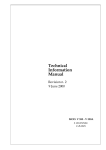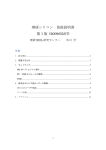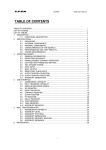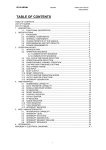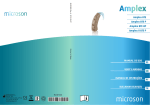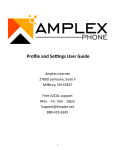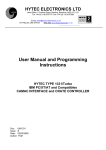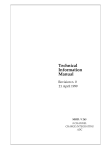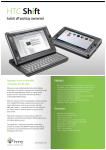Download 7HFKQLFDO ,QIRUPDWLRQ 0DQXDO
Transcript
7HFKQLFDO ,QIRUPDWLRQ 0DQXDO 9HUVLRQ 9 July 1999 02'9% C-RAMS SEQUENCER 09/07/99 V551B User's Manual Version 1.1 TABLE OF CONTENTS TABLE OF CONTENTS ...............................................................................................................i LIST OF FIGURES.......................................................................................................................ii LIST OF TABLES.........................................................................................................................ii 1. DESCRIPTION ......................................................................................................................1 1.1. FUNCTIONAL DESCRIPTION..............................................................................1 2. SPECIFICATIONS.................................................................................................................3 2.1. INPUTS .................................................................................................................3 2.2. OUTPUTS .............................................................................................................3 2.3. OTHER COMPONENTS .......................................................................................4 2.4. POWER REQUIREMENTS...................................................................................4 3. VME INTERFACE..................................................................................................................7 3.1. ADDRESSING CAPABILITY.................................................................................7 3.2. DATA TRANSFER CAPABILITY...........................................................................7 3.3. MODULE IDENTIFIER WORDS ...........................................................................8 3.4. INTERRUPT VECTOR REGISTER ......................................................................9 3.5. INTERRUPT LEVEL REGISTER ..........................................................................9 3.6. CLEAR REGISTER ...............................................................................................9 3.7. TRIGGER REGISTER...........................................................................................9 3.8. STATUS REGISTER.............................................................................................10 3.9. TEST REGISTER..................................................................................................11 3.10. NUMBER OF CHANNELS REGISTER.................................................................11 3.11. T1 REGISTER.......................................................................................................12 3.12. T2 REGISTER.......................................................................................................12 3.13. T3 REGISTER.......................................................................................................12 3.14. T4 REGISTER.......................................................................................................13 3.15. T5 REGISTER.......................................................................................................13 3.16. WRITE INTERNAL DAC .......................................................................................13 4. OPERATING MODES ...........................................................................................................14 4.1. GENERAL INFORMATION ...................................................................................14 4.2. CONNECTION SCHEMES ...................................................................................16 4.2.1. USING MOD. V550 AND V551B WITH JAUX DATAWAY ...................16 4.2.2. USING MOD. V550 AND V551B WITHOUT JAUX DATAWAY............18 4.3. POWER-ON CONFIGURATION...........................................................................20 4.4. STANDARD OPERATIONS ..................................................................................20 4.5. TEST OPERATIONS.............................................................................................22 4.6. INTERRUPT GENERATION .................................................................................23 5. REFERENCES ......................................................................................................................24 APPENDIX A: ELECTRICAL DIAGRAMS ...................................................................................A.1 i 09/07/99 V551B User's Manual Version 1.1 LIST OF FIGURES Fig. 1.1: Block Diagram................................................................................................................2 Fig. 2.1: Front Panel.....................................................................................................................5 Fig. 2.2: Components Locations ..................................................................................................6 Fig. 3.1: Module Identifier Words .................................................................................................8 Fig. 3.2: Interrupt Vector Register ................................................................................................9 Fig. 3.3: Interrupt Level Register..................................................................................................9 Fig. 3.4: Status Register...............................................................................................................10 Fig. 3.5: Test Register..................................................................................................................11 Fig. 3.6: Number of Channels Register........................................................................................11 Fig. 3.7: T1 Register.....................................................................................................................12 Fig. 3.8: T2 Register.....................................................................................................................12 Fig. 3.9: T3 Register.....................................................................................................................12 Fig. 3.10: T4 Register...................................................................................................................13 Fig. 3.11: T5 Register...................................................................................................................13 Fig. 3.12: Internal DAC.................................................................................................................13 Fig. 4.1: System Layout with connections via Auxiliary VME bus ................................................17 Fig. 4.2: System Layout with Connections without Auxiliary VME bus ........................................19 Fig. 4.3: Standard Operation Sequence.......................................................................................21 Fig. 4.4: Test Operation Sequence ..............................................................................................22 LIST OF TABLES Table 3.1: Address Map ...............................................................................................................8 ii 09/07/99 V551B User's Manual Version 1.1 1. DESCRIPTION 1.1. FUNCTIONAL DESCRIPTION The Model V551B CAEN C-RAMS Sequencer is a 1-unit wide VME module that handles the Data Acquisition from multiplexing front-end chips. The module is well suited to handle the VA family of chips (produced by IDE AS, Oslo) but due to its flexibility it can also be used with similar chips (Amplex, Gasplex, etc.). The V551B has been developed to control the signals from/to the C-RAMS (CAEN Readout for Analog Multiplexed Signals) boards Mod. V550, the latter taking care of the conversion of the multiplexed signals from the front end boards housing the above chips. A single V551B can control up to 19 C-RAMS modules in a complete VME crate, thus enabling the readout of 19*(2*2016) = 76608 multiplexed detector channels. The Mod. V551B is controlled via VME bus. The number N of detector channels to be read out by the C-RAMS can be programmed via VME up to 2047 (though the V550 C-RAMS can accept up to 2016 detector channels). The multiplexing frequency can be set via VME from 100 kHz to 5 MHz, with programmable Duty Cycle. The delay between the multiplexing Clock signal and the Convert signal of the acquisition cards can be adjusted to wait for the settlement of the analog signal coming from the multiplexers. The delay between the Trigger and the Hold signal and the delay between the Hold and the Conversion Cycles are also programmable, thus extending the Module's flexibility. The module houses a VME RORA INTERRUPTER[1]: via VME it is possible to program the interrupt generation on the condition that the DRDY signal is asserted, signaling that at least one channel in a system has data to be read out. The V551B Model uses the P1 and P2 connectors of VME and, optionally, the auxiliary connector for the CERN V430 VMEbus crate (Jaux Dataway)[1, 2] in order to handle, if desired, the CONV, DRDY and CLOUT signals via the Jaux connector. The module works in A24/A32 mode. The data transfer occurs in D16 mode. Page 1 of 24 09/07/99 V551B User's Manual Version 1.1 IDENTIFIER TRIG NCH, T1..T5 CONV BUSY VME INTERFACE MAIN SEQUENCER CLIN IRQ CLOUT INTERRUPTER INT. LEVEL CONTROL STATUS /ID DRDY Fig. 1.1: Block Diagram Page 2 of 24 09/07/99 V551B User's Manual Version 1.1 2. SPECIFICATIONS 2.1. INPUTS - DATA READY: Std. TTL. level, 50 Ω impedance (also on Jaux), active high, on a LEMO 00 type connector. A green LED lights up when a DRDY signal is asserted. - TRIG(1): Std. NIM level, high impedance, on two LEMO 00 type bridged connectors (for daisy chaining); requires termination if not chained, see note (1) here below. min. width: 50 ns, must be active high. A green LED lights up when a TRIG signal is asserted. - CLEAR IN(1): Std. NIM level, high impedance, on two LEMO 00 type bridged connectors (for daisy chaining); requires termination if not chained, see note (1) here below. Min. width 50 ns. (1) This is a high impedance input and is provided with two bridged connectors for daisy chaining. Note that the high impedance makes this input sensitive to noise, so the chain has to be terminated on 50 Ω on the last module; the same is needed also if one module only is used, whose input has thus to be properly matched. 2.2. OUTPUTS - BUSY: Std. TTL positive open collector on 50 Ω impedance, active high. Two LEMO 00 type bridged connectors (for daisy chaining). A red LED lights up when a BUSY signal is asserted. - CONTROL: Header 3M type, 10+10 pins, carrying the following signals: VCAL: Analog Voltage, 0 to 5 V, 50 mA max. current, Positive or Negative polarity (selection via DIP switch SW1). TEST PULSE: TTL differential level, 110 Ω impedance, Active high. TEST ON: TTL differential level, 110 Ω impedance, Active high. DELAY ON: TTL differential level, 110 Ω impedance, Active high. SHIFT IN: TTL differential level, 110 Ω impedance, Active low. An SH-IN test point allows to monitor the SHIFT-IN signal. CLOCK: TTL differential level, 110 Ω impedance, Active low. A CLOCK test point allows to monitor the CLOCK signal. HOLD: TTL differential level, 110 Ω impedance, Active low. A HOLD test point allows to monitor the HOLD signal. DRESET: TTL differential level, 110 Ω impedance, Active high. ARESET: TTL differential level, 110 Ω impedance, Active low. N.B.: The CLOCK, CONV, HOLD and SH-IN signals on test points are std. TTL level, all active high (disregarding their active level on the Control Bus and front panel connectors). Page 3 of 24 09/07/99 V551B User's Manual Version 1.1 - CONVERT: Std. NIM level on 50 Ω impedance; two LEMO 00 type connectors (fan-out of 2). differential ECL on Jaux connector, active high. A CONV test point allows to monitor the CONVERT signal. A green LED lights up during a convert cycle. - CLEAR OUT: Std. NIM level on 50 Ω impedance; two LEMO 00 type connectors (fan-out of 2). differential ECL on Jaux connector. 2.3. OTHER COMPONENTS (refer to Fig. 2.1, 2.2) DISPLAYS - 1, "DTACK", green LED, VME Selected. It lights up during a VME access or an Interrupt Acknowledge cycle. INTERNAL SWITCHES - 1 DIP switch "SW1"; to perform the polarity selection of the VCAL voltage (positive, negative). - 1 DIP switch "SW2 (ARESET)"; to enable/disable the analog reset to the front end chips (ON=Enabled). - 2 DIP switches "SW3 (CONV)"; to enable/disable the CONV generation via the Jaux backplane lines CK and CK* (ON=Enabled). - 1 DIP switch "SW4 (DRDY)"; to enable/disable the DRDY detection on the Jaux backplane line SG (ON=Enabled). - 2 DIP switches "SW5 (CLEAR)"; to enable/disable the CLEAR generation via the Jaux backplane lines CL and CL* (ON=Enabled). - 1 DIP switch "SW6 (VEE/AUX)"; for the -5 V power selection: via this switch it is possible to choose the -5 V power supply coming from the -12 V VME power supply (V EE position) or directly from the -5 V Jaux power supply (AUX position). - 4 rotary switches for the module's VME Base Address selection. N.B.: By setting the three DIP switches SW3, SW4 and SW5 in the OFF position, it is possible to disable the CONV, CLEAR and DRDY signals handling via Jaux backplane. In this case the CK, CK*, CL, CL* and SG Jaux lines are disconnected. 2.4. POWER REQUIREMENTS + 12 V − 12 V +5V −5V 100 mA 350 mA (100 mA when Jaux is used) 1A 250 mA (only if Jaux is used) Page 4 of 24 09/07/99 V551B User's Manual Version 1.1 Mod. V560E Mod. V551B VME selected LED CLOCK signal test point DTACK CLOCK CONVERT signal test point HOLD signal test point CONV HOLD SHIFT IN signal test point SH-IN CONVERT output DATA READY input TRIGGER input C O N V - + D R D Y T R I G GND VCAL GND GND - + TEST PULSE TEST ON C O N T R O L DELAY ON SHIFT IN CK BUSY output CLEAR input CLEAR output HOLD B U S Y C L I N TEST ON DELAY ON SHIFT IN CK HOLD DRESET DRESET ARESET ARESET C L O U T 16 CH C - RAMS SEQUENCER Fig. 2.1: Front Panel Page 5 of 24 TEST PULSE 09/07/99 V551B User's Manual Version 1.1 Base address bit <23..20> Rotary switches for Base Address selection Base address bit <19..16> VME P1 connector ON SW2 ON ARESET CONV SW3 DRDY SW4 CLEAR SW5 NEG SW1 AUX SW6 POS VEE Paux connector for CERN VMEbus crate type V430 VME P2 connector Component side of the board Base address bit <27..24> Rotary switches for Base Address selection Base address bit <31..28> Fig. 2.2: Components Locations Page 6 of 24 09/07/99 V551B User's Manual Version 1.1 3. VME INTERFACE 3.1. ADDRESSING CAPABILITY The module works in A24/A32 mode. This implies that the module's address must be specified in a field of 24 or 32 bits. The Address Modifier codes recognized by the module are: AM = %3D AM = %39 AM = %0D AM = %09 A24 supervisory data access; A24 non privileged data access; A32 supervisory data access; A32 non privileged data access; The module's Base Address is fixed by 4 internal rotary switches housed on two piggyback boards plugged into the main printed circuit board (see Fig. 2.2). The Base Address can be selected in the range: % 00 0000 <-> % FF 0000 A24 mode % 0000 0000 <-> % FFFF 0000 A32 mode The Address Map of the page is shown in Table 3.1 on the following page. 3.2. DATA TRANSFER CAPABILITY The internal registers are accessible in D16 mode. Page 7 of 24 09/07/99 ADDRESS V551B User's Manual Version 1.1 REGISTER/CONTENT TYPE Base + %FE Base + %FC Base + %FA Version & Series Manufacturer & module type Fixed code read only read only read only Base + %18 Base + %16 Base + %14 Base + %12 Base + %10 Base + %0E Base + %0C Base + %0A Base + %08 Base + %06 Base + %04 Base + %02 Base + %00 Internal DAC T5 Register T4 Register T3 Register T2 Register T1 Register Number of channels Test Register Status Register Software Trigger Software Clear Interrupt Level Interrupt Vector write only read/write read/write read/write read/write read/write read/write read/write read/write read/write read/write write only write only Table 3.1: Address Map 3.3. MODULE IDENTIFIER WORDS (Base address + %FA ,+ %FC, + %FE, read only) The three words located at the highest address of the page are used to identify the module as shown in figure 3.1: 15 14 13 12 11 10 9 V e r s i o n F i x e d 7 M o d u l e ' s Manufacturer number % F A 8 6 5 s e r i a l M o d u l e c o d e % F 5 4 3 2 1 n u m b e r Address Base + % FE Base + % FC t y p e F i x e d 0 c o d e Base + % FA Fig. 3.1: Module Identifier Words At the address Base + %FA, the two particular bytes allow the automatic localization of the module. For the Mod. V551B the word at address Base + %FC has the following configuration: Manufacturer N° = Type of module = 000010 b 0000111100 b The word located at the address Base + %FE identifies the single module via a serial number, and any change in the hardware will be shown by the Version number. Page 8 of 24 09/07/99 V551B User's Manual Version 1.1 3.4. INTERRUPT VECTOR REGISTER (Base address + %00, write only) This register contains the value of the STATUS/ID that the V551B INTERRUPTER places on the VME data bus during the Interrupt Acknowledge cycle. 15 14 13 12 11 10 9 8 7 6 5 4 3 2 1 0 STATUS /I D Interrupt STATUS/ID Fig. 3.2: Interrupt Vector Register 3.5. INTERRUPT LEVEL REGISTER (Base address + %02, write only) This register contains the value of the Interrupt Level that the V551B INTERRUPTER places on the VME data bus during the Interrupt Acknowledge cycle. 15 14 13 12 11 10 9 8 7 6 5 4 3 2 1 0 INT. LEV. Interrupt level Fig. 3.3: Interrupt Level Register 3.6. CLEAR REGISTER (Base address + %04 read/write) A VME access (read or write) to this location causes the following: 1. a pulse (500 ns) is generated on the CLEAR output; 2. a pulse (500 ns) is generated on the DRESET line of the CONTROL BUS; 3. a pulse (500 ns) is generated (if enabled) on the ARESET line of the CONTROL BUS; 4. if the conversion sequence is in progress, it is aborted and this causes an anticipated pulse (1 µs duration) on the DRESET (also ARESET if enabled) line of the CONTROL BUS; the BUSY output becomes not active. 3.7. TRIGGER REGISTER (Base address + %06 read/write) A VME access (read or write) to this location starts a conversion sequence. The same action is performed if the TRIGGER input signal is active. Page 9 of 24 09/07/99 V551B User's Manual Version 1.1 3.8. STATUS REGISTER (Base address + %08, read/write) 15 14 13 12 11 10 9 8 7 6 5 4 3 AS B DY 2 1 0 AT V ID INTERNAL DELAY VETO AUTOTRIGGER DATA READY (read only) BUSY (read only) ACTIVE SEQUENCE (read only) Fig. 3.4: Status Register ID INTERNAL DELAY: =0 no INTERNAL DELAY; =1 INTERNAL DELAY selected. V VETO: =0 no VETO state; =1 VETO state. AT AUTOTRIGGER =0 NORMAL mode; =1 AUTOTRIGGER mode. DY DATA READY (read only): =0 no DATA READY; =1 DATA READY. B BUSY (read only): =0 not BUSY ; =1 BUSY. AS ACTIVE SEQUENCE (read only): =0 no ACTIVE SEQUENCE; =1 ACTIVE SEQUENCE. The ACTIVE SEQUENCE bit indicates that the readout sequence is active, i. e. the V551 Module is in a status between an accepted TRIGGER and a DRESET generation Page 10 of 24 09/07/99 V551B User's Manual Version 1.1 3.9. TEST REGISTER (Base address + %0A, read/write) 15 14 13 12 11 10 9 8 7 6 5 4 3 2 1 0 PL SL CL TM TEST MODE CLOCK LEVEL SHIFT-IN LEVEL TEST PULSE LEVEL Fig. 3.5: Test Register TM TEST MODE: =0 NORMAL MODE selected; =1 TEST MODE selected. CL CLOCK LEVEL: =0 not active; =1 active. SL SHIFT LEVEL: =0 not active; =1 active. PL TEST PULSE LEVEL: =0 not active; =1 active. 3.10. NUMBER OF CHANNELS REGISTER (Base address + %0C, read/write) 15 14 13 12 11 10 9 8 7 6 5 4 3 2 1 0 Number of channels Fig. 3.6: Number of Channels Register The number N of detector channels to be read out by the C-RAMS can be programmed via this register up to 2047 (though the V550 C-RAMS can accept only up to 2016 detector channels). Page 11 of 24 09/07/99 V551B User's Manual Version 1.1 3.11. T1 REGISTER (Base address + %0E, read/write) 15 14 13 12 11 10 9 8 7 6 5 4 3 2 1 0 T1 T1 VALUE Fig. 3.7: T1 Register This register allows to set the T1 parameter on 8 bits. It gives the delay t1 between the Leading Edge of the TRIGGER and the HOLD assertion. The actual delay t1 (in nanoseconds) is calculated as follows: t1 = 500 + T1*10 ns, where 0 ≤ T1 ≤ 255. 3.12. T2 REGISTER (Base address + %10, read/write) 15 14 13 12 11 10 9 8 7 6 5 4 3 2 1 0 T2 T2 VALUE Fig. 3.8: T2 Register This register allows to set the T2 parameter on 9 bits. It gives the delay t2 between the HOLD assertion and the start of the CLOCK/CONVERT sequence. The actual delay t2 (in nanoseconds) is calculated as follows: t2 = 130 + T2*20 ± 10 ns, where 10 ≤ T2 ≤ 511. The 10 ns Jitter is due to the synchronization with an internal Oscillator. 3.13. T3 REGISTER (Base address + %12, read/write) 15 14 13 12 11 10 9 8 7 6 5 4 3 2 1 0 T3 T3 VALUE Fig. 3.9: T3 Register This register allows to set the T3 parameter on 8 bits. It gives the duration t3 of the active phase of the CLOCK and the CONVERT. The actual duration t3 (in nanoseconds) is calculated as follows: t3 = T3*20 ns, where 1 ≤ T3 ≤ T4 and T3 ≤ 255. This constraint (T3 ≤ T4) follows automatically from the fact that the active phase of the CLOCK and CONVERT must be less than their own period. Page 12 of 24 09/07/99 V551B User's Manual Version 1.1 3.14. T4 REGISTER (Base address + %14, read/write) 15 14 13 12 11 10 9 8 7 6 5 4 3 2 1 0 T4 T4 VALUE Fig. 3.10: T4 Register This register allows to set the T4 parameter on 9 bits. It gives the period t4 of both the CLOCK and the CONVERT sequence. The actual period t4 (in nanoseconds) is calculated as follows: t4 = 20 + T4*20 ns, where 1 ≤ T4 ≤ 511. 3.15. T5 REGISTER (Base address + %16, read/write) 15 14 13 12 11 10 9 8 7 6 5 4 3 2 1 0 T5 T5 VALUE Fig. 3.11: T5 Register This register allows to set the T5 parameter on 9 bits. In NORMAL MODE, it gives the delay t5 between the CLOCK and the relevant CONVERT. The actual delay t5 (in nanoseconds) is calculated as follows: t5 = 40 + T5*20 ns, where 2 ≤ T5 ≤ 511. In TEST MODE, it gives the delay t6 between the leading edge of the TEST PULSE and the first CONVERT pulse. The actual delay t6 (in nanoseconds) is calculated as follows: t6 = 150 + T5*20 ± 10 ns, where 2 ≤ T5 ≤ 511. The 10 ns Jitter is due to the synchronization with an internal Oscillator. 3.16. WRITE INTERNAL DAC (Base address + %18, write only) 15 14 13 12 11 10 9 8 7 6 5 4 3 2 1 0 DAC VALUE INTERNAL DAC Fig. 3.12: Internal DAC This register allows to set the Analog positive voltage VCAL on the front panel "CONTROL" connector. It is 12 bits long and the full scale value (%FFF) corresponds to a +5 V, 50 mA (max.) output on the VCAL line. The polarity can be changed via an internal DIP switch (SW1). Page 13 of 24 09/07/99 V551B User's Manual Version 1.1 4. OPERATING MODES 4.1. GENERAL INFORMATION The Model V551B CAEN C-RAMS is well suited to handle the VA family of chips (produced by IDE AS, Oslo) but due to its flexibility it can also be used with similar chips (Amplex, Gasplex, etc.). The V551B has been developed to control the signals from the C-RAMS boards Mod. V550, the latter taking care of the conversion of the multiplexed signals from the multiplexer boards housing the above chips. A "CONTROL" Bus allows the use of this Module with the VA Repeater Cards (or similar). The module handles three kinds of signals: a) Signals that interface with the "External World"; b) Signals that interface with the V550 C-RAMS Modules c) Signals that interface with the VA Repeater Cards (or similar) a) EXTERNAL WORLD SIGNALS: - TRIGGER (TRIG). It is a pulse (NIM level, provided via front panel connectors) whose leading edge starts all the conversion sequence. The User should provide this signal to the module to start the whole acquisition. Software generation of the TRIGGER is also available (see §3.7). A TRIG is accepted if the Module is not in a BUSY status. - CLEAR IN (CLIN). It is a pulse (NIM level) that resets the V551B board. It can be used as a Fast Clear to abort the current multiplexer readout cycle. The User should provide this signal to the module to abort the whole acquisition. A CLEAR IN pulse causes the following: 1. a pulse is generated on the CLOUT output (same duration as CLIN); 2. a pulse is generated on the DRESET line of the CONTROL BUS (same duration as CLIN); 3. a pulse is generated (if enabled) on the ARESET line of the CONTROL BUS (same duration as CLIN); 4. if the conversion sequence is in progress, it is aborted and this causes an anticipated pulse (1 µs duration) on the DRESET (also ARESET if enabled) line of the CONTROL BUS; the BUSY output becomes not active. Software generation of the CLEAR IN is also available (see §3.6). - BUSY (BUSY). It is a positive open collector signal available on a front panel connector that indicates that the system cannot accept new events. In this case the TRIGGER signal is ignored. The BUSY condition occurs in the following cases: - when the V551B Sequencer itself is in the conversion phase; - when the wired-OR of the DRDY signals is high (VME reading phase in progress); - when CLOUT is asserted. The BUSY is removed with the occurrence of one of the following: - Front-end chips read out but no data in the V550 buffers; - All data read out from the V550 buffers; - External or software Clear. Page 14 of 24 09/07/99 V551B User's Manual Version 1.1 b) C-RAMS SIGNALS: - CONVERT (CONV). It is the start of conversion pulse available on a front panel connector (NIM level), or via CK and CK* pins of the Jaux backplane connector of the V430 VME crate (ECL level), that goes to all the channels of the V550 Modules. - CLEAR OUT (CLOUT). It is a pulse available on a front panel connector (NIM level) or via CL and CL* pins of the Jaux backplane connector, (ECL level). It is asserted when a software CLEAR is performed or when CLEAR IN is asserted. It can be used to reset the acquisition cards (V550). - DATA READY (DRDY). It is a signal (TTL level) that indicates, by means of a wired-OR of the DRDY signals coming from the acquisition cards (V550), that at least one of such modules is in DATA READY state and so has data to be read out. The DRDY signal is provided via front panel connectors or via the SG pin of the Jaux connector of the V430 crate. N.B.: The Jaux signals can be disabled via internal DIP switches. c) REPEATER CARD SIGNALS: - CLOCK (CK). It is a signal, active low, available on a front panel CONTROL connector (TTL differential level) that is provided to the Front End chips (multiplexers clock). - SHIFT IN. It is a pulse, active low, available on a front panel CONTROL connector (TTL differential level) that causes a TOKEN input to the first of the Front End chips in a multiplexing chain. - HOLD. It is a level, active low, available on a front panel CONTROL connector (TTL differential level) that generates a Track/Hold in the Front End chips. The HOLD status starts with the peaking time of the shaper and terminates at the end of the readout from the multiplexer. - DELAY ON. It is a level, active high, available on a front panel CONTROL connector (TTL differential level) that enables the internal HOLD delay in the VA chips. - DIGITAL RESET (DRESET). It is a pulse, active high, available on a front panel CONTROL connector (TTL differential level) sent to the Repeater cards at the end of a readout sequence or after a CLEAR. - ANALOG RESET (ARESET). It is a pulse, active low, available on a front panel CONTROL connector (TTL differential level) sent to the Repeater cards after a CLEAR. - TEST ON. It is a level, active high, available on a front panel CONTROL connector (TTL differential level) that places the VA chips in TEST mode. It is generated when the V551B itself is placed in TEST mode. - TEST PULSE. It is a level, active high, available on a front panel CONTROL connector (TTL differential level) generated via VME. - VCAL. It is an Analog Voltage Level, 0 to 5 V, 50 mA max. current, programmable via VME. Page 15 of 24 09/07/99 V551B User's Manual Version 1.1 4.2. CONNECTION SCHEMES The Model V551B CAEN C-RAMS Sequencer has been designed to control several C-RAMS (CAEN Readout for Analog Multiplexed Signals) units, Mod. V550, in a single acquisition system. When a Mod. V551B C-RAMS Sequencer controls more than one V550 channel, the CONVERT signal is the same for each channel, so that each multiplexer is controlled by a single CLOCK. In order to operate the whole system properly, some connections must be performed between the V550 C-RAMS modules and the V551B Sequencer module. The V551B CONVERT and CLEAR OUT signals must be distributed to the C-RAMS acquisition cards and the V550 and V551B DATA READY signals must be connected together to perform a wired-OR. All this may involve the use of a large number of 50 Ω coaxial cables. The Mod. V551B uses optionally the auxiliary connector for the CERN V430 VME bus crate (Jaux Dataway): if the VME auxiliary bus is available, it is possible to send via backplane the CONVERT, CLEAR OUT and DRDY signals and all the connections mentioned above can be avoided. 4.2.1. USING MOD. V550 AND V551B WITH JAUX DATAWAY By means of DIP switches, both on the V550 and V551B boards, it is possible to enable the Jaux Dataway (see § 2.3) to accomplish the following: 1) The CONVERT signal coming from the V551B module is distributed to the V550 channels. 2) The CLEAR OUT signal coming from the V551B module is distributed to the V550 channels. 3) The wired-OR of the V550 DATA READY signals is performed and received by the DRDY input of the Mod. V551B. If on the backplane there is no termination on the CK, CK*, CL and CL* auxiliary VME bus lines, the CLEAR and CONVERT signals must be terminated otherwise. For this purpose, a removable termination package (50 Ω to VTT) can be installed on the last V550 C-RAMS module in a Crate (e.g. if a V551B is in slot 3 and five V550 modules are in slots 4 to 8, the termination must be inserted in the V550 in slot 8). See V550 User's Manual for further information. As the DATA READY is a TTL signal, if there is a termination on the SG auxiliary VME bus line, it must be removed from the backplane. N.B.: With the layout shown in Fig. 4.1, it is convenient to set the -5 V power supply selection jumper to AUX. This allows to reduce the power consumption on the -12 V power supply. Page 16 of 24 09/07/99 Mod. V560E Mod. V551B V551B User's Manual Version 1.1 Mod. V560E Mod. V560E Mod. V560E Mod. V550 Mod. V550 Mod. V550 DTACK DTACK DTACK CH0 CH0 DTACK CLOCK CH0 CONV + HOLD I N + I N _ SH-IN + I N _ _ VT T C O N V C O N V D R D Y C O N V C O N V 50 Ohm Auxiliary CERN VME bus CONV CLEAR T R I G D R D Y DRDY 50 Ohm D R D Y D R D Y - + CH1 To Repeater Cards 50 Ohm C O N T R O L CH1 + I N I N _ B U S Y C L I N CH1 + + I N _ _ C O N V C O N V C O N V D R D Y D R D Y D R D Y C L E A R C L E A R C L E A R 50 Ohm C L O U T 16 CH C - RAMS SEQUENCER 16 CH SCALER 16 CH SCALER 16 CH SCALER C - RAMS C - RAMS C - RAMS Fig. 4.1: System Layout with connections via Auxiliary VME bus Page 17 of 24 09/07/99 V551B User's Manual Version 1.1 4.2.2. USING MOD. V550 AND V551B WITHOUT JAUX DATAWAY If the auxiliary VME bus is not available or if the User prefers not to use it (in this case the Jaux Dataway DIP switches must be disabled), the following connections must be performed: - The CONVERT signal must be distributed via 50 Ω coaxial cables from the V551B to the relevant CONV connectors on the V550 Modules in a daisy chain connection. A 50 Ω termination must be inserted in the free CONV connector of the last V550 in a chain. - The CLEAR OUT signal must be distributed via 50 Ω coaxial cables from the V551B to the relevant CLEAR connectors on the V550 Modules in a daisy chain connection. A 50 Ω termination must be inserted in the free CLEAR connector of the last V550 in a chain. - All the DATA READY connectors on the V550 Modules and the relevant DRDY connector on the V551B must be connected via 50 Ω coaxial cables in a daisy chain connection. In this case, the 50 Ω termination is not necessary, as the DRDY connector on the V551B is already terminated. It can be useful to note that the CONVERT and CLEAR OUT signals are provided with a fan-out of 2 via the V551B front panel connectors. The load can be thus divided in two chains. In this case, the 50 Ω termination must be placed on both free CONV and CLEAR OUT connectors of the two last loads in the chains. N.B.: If the V430 crate is not used, the -5 V power supply selection jumper must be set to VEE. This allows to obtain the -5 V from the -12 V power supply. Page 18 of 24 09/07/99 Mod. V560E Mod. V551B V551B User's Manual Version 1.1 Mod. V560E Mod. V560E Mod. V560E Mod. V550 Mod. V550 Mod. V550 DTACK DTACK DTACK CH0 CH0 DTACK CLOCK CH0 CONV + HOLD I N + I N _ SH-IN + I N _ _ C O N V D R D Y T R I G 50 Ohm C O N V C O N V D R D Y D R D Y C O N V 50 Ohm D R D Y - + CH1 To Repeater Cards 50 Ohm C O N T R O L CH1 + I N I N _ C O N V B U S Y CH1 + + I N _ C O N V _ C O N V 50 Ohm C L I N D R D Y D R D Y C L E A R C L E A R D R D Y 50 Ohm C L O U T 16 CH C - RAMS SEQUENCER C L E A 50 R Ohm 16 CH SCALER 16 CH SCALER 16 CH SCALER C - RAMS C - RAMS C - RAMS Fig. 4.2: System Layout with Connections without Auxiliary VME bus Page 19 of 24 09/07/99 V551B User's Manual Version 1.1 4.3. POWER-ON CONFIGURATION At Power-On, most of the V551B Module is in an undetermined state. All registers MUST thus be programmed in order to operate the Module. The only determined configurations (i.e. being always in this status at Power-On) are the following (see §3.5, §3.8, §3.9): a) INTERRUPT LEVEL = 0 (Interrupt Disabled); b) no INTERNAL DELAY; c) VETO OFF; d) AUTOTRIGGER OFF; e) NORMAL MODE selected (NO TEST MODE); f) CLOCK LEVEL NOT ACTIVE (TEST MODE); g) SHIFT LEVEL NOT ACTIVE (TEST MODE); h) TEST PULSE LEVEL NOT ACTIVE (TEST MODE). If the Module is not programmed at Power On, or if uncorrect settings are performed (see §4), any further operation (e.g. sending a TRIGGER) may set the Module in a severe undetermined state: in this case, the only way to exit this state is to send a CLEAR and to program correctly the registers of the Module. 4.4. STANDARD OPERATIONS (refer to fig. 4.3) In order to proceed with an ordinary acquisition cycle, the User must perform a series of settings, and thereafter start with the ordinary cycle. The following describes the settings to be done and the corresponding operation sequence. The readout sequence starts with an external or a VME TRIGGER. The BUSY becomes active, indicating that the module cannot accept another TRIGGER. The leading edge of the TRIGGER starts a monostable multivibrator circuit. This circuit, after a time t1 programmable via VME in 10 ns steps in the range 500 ns to 3 µs approx. (see §3.11), activates the HOLD and the SHIFT IN signals (the latter after t1+300 ns). The HOLD signal is used to sample the signal at the output of the shapers at peaking time. The SHIFT-IN is the TOKEN signal for the first chip in the multiplexing chain, and must be active at the occurrence of the first CLOCK. For this purpose, a hold time of 100 ns is provided. Once the HOLD is asserted, the CLOCK cycles begin after a time t2 programmable via VME in 20 ns steps in the range 170 ns to 10 µs approx. (see §3.12). The CLOCK is generated by an internal 50 MHz oscillator: due to this, the actual begin of the readout (i.e. the first MUX CLOCK) will be delayed with respect to the HOLD assertion with a ±10 ns Jitter. In the following readout sequence, N CLOCK and CONVERT pulses are generated. The number N of detector channels (between 1 and 2047) can be programmed via VME (though the V550 C-RAMS can accept up to 2016 detector channels). Each CLOCK pulse is followed by a CONVERT pulse after a delay of t5 ns, programmable via VME in 20 ns steps in the range 80 ns to 10 µs approx. (see §3.15). The purpose of this delay is to wait for the settlement of the analog signal coming from the multiplexers. The width of the active phase of the CLOCK and CONVERT pulses is t3 ns, programmable via VME in 20 ns steps in the range 20 ns to 5 µs approx. (see §3.13). N. B.: The V550 accepts only CONVERT pulses with active phase ≥ 100 ns, see V550 User's Manual. Page 20 of 24 09/07/99 V551B User's Manual Version 1.1 The repetition period t4 of the CLOCK and CONVERT pulses (and consequently the multiplexing frequency) is programmable via VME in 20 ns steps in the range 40 ns to 10 µs approx. (see §3.14). The CLOCK, CONVERT, HOLD and SHIFT-IN signals are available on four test points placed on the front panel. The active level on the test points is always high, disregarding the normal level of the relevant signals on the front panel connectors (see §2.4). With the last CONVERT pulse, the DRESET line (also the ARESET if enabled) becomes active for a 1 µs time, thus resetting the front end circuitry. After the generation of the last CONVERT pulse, the BUSY signal becomes not active if none of the V550 acquisition cards has asserted the DRDY signal. Otherwise, when the DRDY has been raised (at least one channel has data ready), the BUSY signal remains high until all the V550 FIFOs have been read out, i.e. until the DRDY becomes not active. A software controlled VETO is also available. The VETO forces the V551B in a BUSY condition (no TRIGGER accepted). t1 t2 TRIGGER /HOLD t4 /CLOCK ...N pulses... t3 ...N pulses... CONVERT t5 /SHIFT IN 300 ns 100 ns BUSY 1 µs DRESET /ARESET 1 µs DRDY Fig. 4.3: Standard Operation Sequence Page 21 of 24 09/07/99 V551B User's Manual Version 1.1 4.5. TEST OPERATIONS The V551B Module features a Test Mode operation that allows the User to test its acquisition chain. In order to proceed with a test acquisition cycle, the User must perform a series of settings, and thereafter start with the test cycle. The following describes the settings to be done and the corresponding operation sequence. The TEST mode is enabled via VME setting to 1 bit 0 of the TEST Register (see §3.9). The TEST ON line of the CONTROL bus sets the VA chips in Test Mode. When the Module is in Test Mode, it is possible to drive the CLOCK, SHIFT IN and TEST PULSE lines via VME (see §3.9) in order to switch the multiplexer on the desired channel and produce a test pulse. The transitions on these lines occur at the same time corresponding to the VME access. N.B.: Due to the fact that it is possible to set only the level of these signals, the User should take care of generating the appropriate sequence via software. The leading edge of the TEST PULSE is used to trigger a series of CONVERT pulses (see fig. 4.4). The delay t6 between the leading edge of the TEST PULSE and the first CONVERT pulse is programmable via VME in 20 ns steps in the range 190 ns to 10 µs approx. (see §3.15). The number of convert pulses N (number of channels), the width t3 of the active phase of the CONVERT pulse and the repetition period t4 of the CONVERT pulses are programmable via VME as in the Normal mode (see §4.4). These pulses allow to acquire the response of the VA chips to a TEST PULSE. In Test Mode, the HOLD signal remains not active, the BUSY is not generated and the TRIGGER is ignored. Via VME it is possible to set a positive (or negative, selection via SW1, see §2.3) Analog Voltage (VCAL) via an internal 12 bit DAC (see §3.16). Full scale value is 5 V with a maximum current of 50 mA. This level can be used to shape a pulse for test purposes after a TEST PULSE generation. t6 TEST PULSE t3 ...N pulses... CONVERT t4 Fig. 4.4: Test Operation Sequence Page 22 of 24 09/07/99 V551B User's Manual Version 1.1 Another test operating mode is achieved by using the AUTOTRIGGER feature. It allows an automatic generation of readout sequences, not synchronized with any TRIGGER, that occur repeatedly at the maximum frequency compatible with the performed settings. The AUTOTRIGGER must be operated only in NORMAL MODE (bit 0 of Test Register set to 0, see §3.9). To enter the AUTOTRIGGER mode, the User should set to 1 the relevant bit of the STATUS Register (see §3.8). The actual occurrence of the repeated sequences will occur with an external or VME TRIGGER. To exit AUTOTRIGGER mode, the User should set to 0 the relevant bit of the STATUS Register (see §3.8). This stops automatically the generation of readout sequences. 4.6. INTERRUPT GENERATION The operations of the V551B VME RORA INTERRUPTER are fully programmable; via VME it is possible: • to set the VME Interrupt level; • to program the VME Interrupt Vector (STATUS/ID); The interrupt is generated on the assertion of the DRDY input signal, which is the logical wired-OR of all DRDY signals coming from the acquisition cards. Thus, the interrupt is requested when, at the end of the readout sequence, at least one channel in the system has data to be read out, and is released when all the FIFOs have been completely read out. If the Interrupt Level is set to 0, no Interrupts will be generated from the V551B Module. Page 23 of 24 09/07/99 V551B User's Manual Version 1.1 5. REFERENCES [1] VMEbus Specification Manual Revision C.1, October 1985. [2] G. Bianchetti et al., "Specification for VMEbus CRATE Type V430", CERN-EP, January 1990. Page 24 of 24 09/07/99 V551B User's Manual Version 1.1 APPENDIX A: ELECTRICAL DIAGRAMS A.1




























